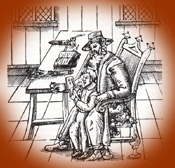


TOWARDS DIGITAL STORYTELLING FOR CHILDREN
THE EVOLUTION OF STORYTELLING FROM THE MIDDLE AGES
- Middle Ages - Oral Tradition
- 1400-1500's - Instruction
- 1600's - Enjoyable Learning
- 1700's - Introduction of Adventure
- 1800's - Storytelling that Delights
- 1900's - Too Much, Too Fast
- 1970's - Multimedia Mix
Links
Links will be provided for key words and ideas in the essay. They are marked with an asterisk in the text but can only be accessed from the link column.
Colloquy
Middle-Ages: Oral Tradition
In the middle ages, the tradition of storytelling and instruction was oral. Wandering bards and minstrels told stories and sang ballads. Children listened, joined in the refrains and learned histories, folktales and religious stories. Wandering Mystery, Miracle and Morality plays stopped in villages and at castles during major celebrations. The characters in the plays, with their varied voices and different costumes, brought forth images in the mind rich in religious meaning and children learned about symbolism and about allegory by listening and by watching (Meigs 19). In wealthy homes manuscripts were used by masters to teach children by rote. These included books of courtesy which provided proscriptions and standards of place, primers which taught the alphabet through verse, and catechisms which provided the moral teachings of the day (Demers & Moyles 2).

One of the earliest documents written aimed specifically at children is the Colloquy, written by the 10th century hagiographer and teacher, Aelfric. The Colloquy is written as a dialogue. When the master asks a question, the pupil answers as a monk or a ploughman, a fowler or a merchant. Aelfric's students would assume the persona of another individual during their daily studies (Demers & Moyles 2). (This interactivity is based on creativity not rote and is interesting in light of today's digital "game-playing" scenarios.)